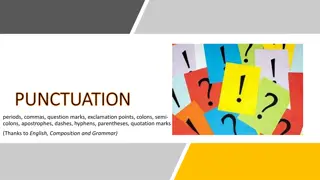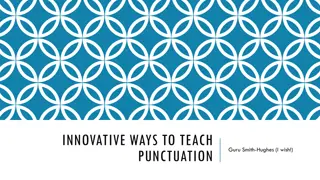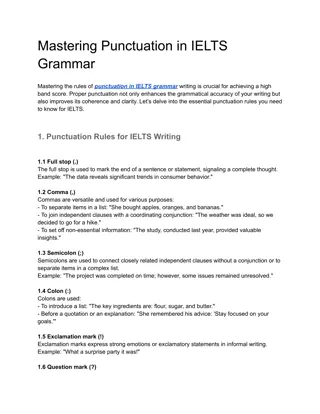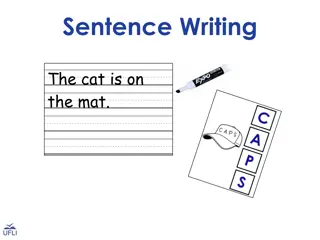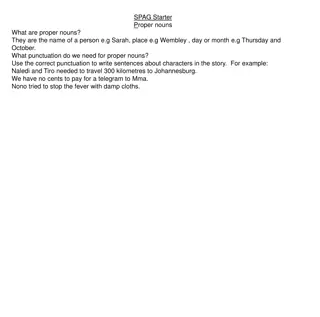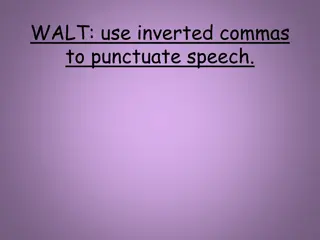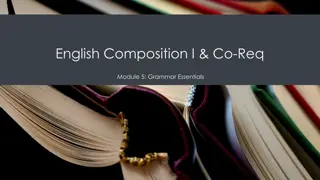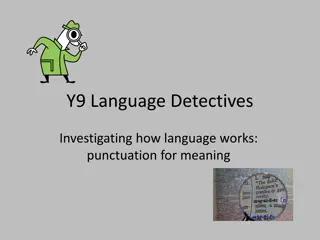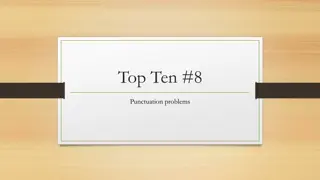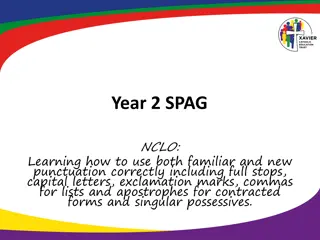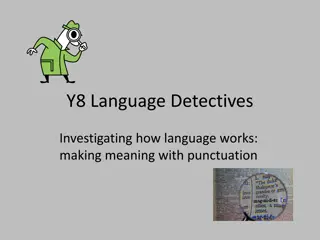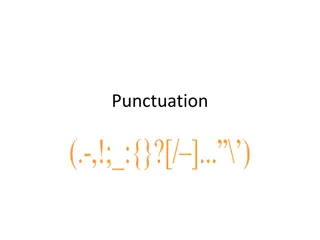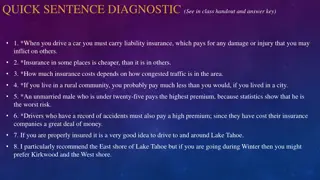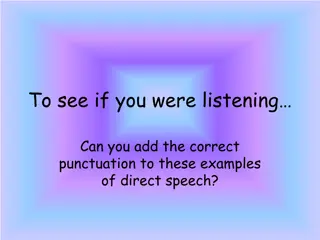Mastering Punctuation in Academic Writing
Understand the essentials of punctuation in academic writing like capitalization, comma usage, semicolons, and more. Poor punctuation can lead to misinterpretation and confusion. Learn the nuances between British and American English punctuation styles to enhance your writing clarity and effectiveness.
Download Presentation

Please find below an Image/Link to download the presentation.
The content on the website is provided AS IS for your information and personal use only. It may not be sold, licensed, or shared on other websites without obtaining consent from the author.If you encounter any issues during the download, it is possible that the publisher has removed the file from their server.
You are allowed to download the files provided on this website for personal or commercial use, subject to the condition that they are used lawfully. All files are the property of their respective owners.
The content on the website is provided AS IS for your information and personal use only. It may not be sold, licensed, or shared on other websites without obtaining consent from the author.
E N D
Presentation Transcript
PUNCTUATION IN ACADEMIC WRITING: What to know and how to use Dr. Cuneyt DEM R The University of Siirt
1.Capitalisation 2.Comma 3.Semicolon 4.Colon 5.Apostrophe 6.Hypen 7.Bracket 8.Question tag 9.Quotation mark OUTLINE 2
The problem with poor punctuation is that it makes life difficult for the reader who needs to read and understand what you've written. Let us eat Grandma. OR Let us eat, Grandma. Don t stopORDon t, stop. I climbed Everest, which is a tough work. I climbed Everest which is a tough work*. Ex: Importance of punctuation 3
British English American English . Full stop Period Exclamation mark Exclamation point ! Inverted commas Quotation mark Differences between BE and AE 4
A A manuscript manuscript with with Sloppy Sloppy Punctuation Punctuation A A manuscript manuscript with with Sloppy Sloppy Punctuation Punctuation Hard Hard to to decode decode the the meaning meaning Hard Hard to to decode decode the the meaning meaning Bored Bored audience audience as as well well as as editors editors & & reviewers reviewers Bored Bored audience audience as as well well as as editors editors & & reviewers reviewers Ineffectual Ineffectual writing writing Ineffectual Ineffectual writing writing Lack Lack of of persuasiveness persuasiveness Low Low scores scores in in the the exams exams Need Need for for language language revision revision Why Why to to avoid avoid it? it? 5
1. The first word after full stop and of every sentence. ex1. The problem was always there. It never disappeared. 2. Days of the week (Tuesday) and months of the year (April). ex2. She will come on the first Tuesday of April. 3. The first letter (only) of the names of people and places ex3. Where are you Mr. Jones? The Nile is the longest river on earth. 4. The main words of a title, but not articles [a, an, the) or prepositions (words like to, of, for) or conjunctions [and, but), unless they are the first word in the title: ex4. Academic Writing in English; Punctuation of a Manuscript But! A Manuscript and Punctuation 5. Special occasions ex5. the Olympic Games, the Cannes Film Festival 6. Races, nationalities, and tribes Note: white and black in reference to race are lowercase ex6. Eskimo, Navajo, East Indian, African American 7. Organizations Environment ex7. American Center for Law and Justice, Norwegian Ministry of the 8. Manmade structures ex8. the Empire State Building, the Eiffel Tower, the Titanic 9. Institutions ex9. Oxford College, the Juilliard School of Music 10. Historical episodes and eras ex10. the Inquisition, the American Revolutionary War, the Great Depression Also: Streets and roads (Roadway), Religions (Muslim, Christian, Islam), Planets (Venus), Nicknames and epithets (Andrew "Old Hickory" Jackson; Babe Ruth, the Sultan of Swat), Natural and manmade landmarks (Mount Everest, the Hoover Dam), Holidays (Easter) Capitalisation ABCD 6
1. Commas between modifiers (ex1) He is a strong, healthy man But! We stayed at an expensive summer resort. 2. Use commas before or surrounding the name or title of a person directly addressed: (ex2) Will you, Aisha, fill in that form for me? (ex3) Yes, Doctor, I will. ! Please note that you should capitalize the title when you are directly addressing someone. 3. Months and years: Use a comma to separate the day of the month from the year: (ex4) Anna met her husband on December 5, 2003, in Lund, Sweden. 4. Commas and sentence flow: Use commas to set off expressions that interrupt sentence flow. (ex5) I am, as you have probably noticed, very nervous about this. ! Please note that an alternative to using commas here would be to use dashes: (ex6) I am as you have probably noticed very nervous about this. (dash is also possible) 5. Commas and dependent clauses: Generally speaking, when starting a sentence with a dependent clause, use a comma after it. Conversely, do not put a comma before the dependent clause when it is found at the end of the sentence: (ex7) If you are not sure about this, let me know now. OR When you come, you ll get what I mean. (ex8) Let me know now if you are not sure about this. OR You ll get what I mean when you come. 6. Commas and non-restrictive postmodifiers: If something or someone is sufficiently identified, the description that follows is considered nonessential and should be surrounded by commas: (ex9) Freddy, who has a limp, was in an auto accident. Comma ( , ) 7
7. Commas and coordinating conjunctions: Use a comma to separate two main clauses joined by one of the coordinating conjunctions and, or, but, for, so, yet, and nor: (ex10) There's no one in the house, and the garden seems to be deserted as well. (ex11) She will have to be fired immediately, or I will leave this firm now. (ex12) I have painted the entire house, but he is still working on sanding the doors. (ex13) They wanted to hire another senior lecturer, so they advertised a post. At least in the case of the conjunction and, we normally omit the comma if the clauses are both really short (ex14) I paint and he writes. or if the sentence is otherwise totally impossible to misunderstand. If the subject is identical in the two conjoined main clauses and omitted from the second one, we do not insert a comma before the conjunction: (ex15) He thought quickly but still did not answer correctly. 8. Commas and tag questions: Use a comma to separate the statement from the tag question: (ex16) I can go, can't I? Contractions (such as can't) are avoided in academic writing, and so are normally tag questions and direct questions in general (that is, we normally use indirect questions instead). 9. Contrasting parts of a sentence: Use a comma to separate contrasting parts of a sentence. (ex17) That is my money, not yours. 10. Before introductory words: Use either a comma or a semicolon before introductory words such as namely, that is, i.e., e.g., for example, or for instance, when they are followed by a series of items. Also put a comma after the introductory word: (ex18) You may be required to bring many items, for example, sleeping bags, pans, and warm clothing. OR (ex19) You may be required to bring many items; for example, sleeping bags, pans, and warm clothing. Comma 2/2 ( , ) 8
1. Between two related sentences: We may use a semicolon to separate two sentences which are closely related in theme or content: (ex1) Come to my office tomorrow; I will have the document prepared. (ex2) Few newly enrolled students know exactly what career path their studies will eventually offer; most find their area of interest during their studies. 2. Before connectors, we may use a semicolon before a connecting word. To the category of connecting words, we may refer the following adverbs: also, anyway, besides, consequently, furthermore, hence, however, incidentally, indeed, moreover, nevertheless, next, nonetheless, otherwise, similarly, still, then, therefore, and thus. Also before connectiong pharase such as all, as a matter of fact, as a result, at the same time, even so, for example, for instance, in addition, in conclusion, in fact, in other words, in the first place, of course, on the contrary, and on the other hand. (ex3) The deadline for the assignment is due tomorrow; therefore, additional study time has been scheduled. (ex4) Exams are a means of measuring ability; however, not everyone performs well in them. (ex5) Exams are a means of measuring ability; as a result, not everyone performs well in them. (ex6) Critical thinking is essential at university; at the same time, it is difficult to teach. 4. In lists: Semi-colons as used to separate complex items in a list in which some of the items already contain commas: (ex7) There are many faculties at a university: Arts; Behavioural, Cognitive and Social Sciences; Humanities; Law; Education; and Rural Medicine and Health. (ex8) (Jones 2007; Johansson & Olofsson 1998; Strongman et al. 2003) Semicolon ( ; ) 9
Colons are often used at the end of an independent clause (a complete sentence), giving focus to the words following the colon. Colons have been described as strong pauses, mainly used to indicate that what follows is an illustration or example of what has been referred to before. According to Silverman, Hughes & Wienbroer (2008), "[c]olons create suspense: they signal that an example, a quotation, or an explanation will follow." They also point out that we cannot use a colon after are, include, and such as. The following situations in which a colon may be used are important to be aware of: 1. Introducing a list (ex1) This essay investigates three aspects of global warming: historical events, environmental influences, and human influences. As mentioned above, we cannot use a colon after, for instance, are, so the following sentence is not a good alternative: (ex2) *This essay investigates three aspects of global warming, which are: historical events, environmental influences, and human influences. 2. Explaining (or illustrating) the previous statement (ex3) The Environmental Management and Policy degree course is highly regarded: academic standards are high, the lecturers cater for on and off campus studies and opens future employment avenues in a variety of fields. 3. Highlighting a single word (ex4) The visiting professor can be summed up in one word: educational. 4. Preceding a (long) quotation (ex5) In view of academic writing being an interactive feat, Hyland (2002, p.1) states the following: "A writer's development of an appropriate relationship with his or her readers is widely seen as central to effective academic persuasion as writers seek to balance claims for the significant, originality, and correctness of their work against the convictions and expectations of their readers." 5. Introducing an emphatic assertion (ex6) This is the bottom line: I refuse to lecture every day. 6. Between the title and the subtitle (ex7) Punctuation in Academic Writing: What to know & How to use Colon ( : ) 10
An apostrophe appears as part of a word to show possession or to indicate the omission of one or more letters (a contraction). Despite this sounding straightforward, it can be confusing even for the native speaker. The two cases are illustrated below. 1. Indicating possession: The most common way to form a possessive in English is to use an apostrophe ' and s. (ex1) The student's article was published in a well recognised magazine. (ex2) Sweden's popularity is growing in global marketing. 2. When the name of the possessor ends in an s, we may write either s's or s' (consider the relevant style guide, if there is one). (ex3) Professor James' lecture was enlightening. (ex4) Professor James's lecture was enlightening. 3. When the possessor ends in a regular plural -s, we only add an apostrophe. (ex5) Research shows that wolves' habits have changed in recent years. 4. If two people possess the same item, an apostrophe and s is used after the second name. (ex6) Persson and Lindberg's article argues that ....... BUT If indicating separate ownership, use an apostrophe and s after both. (ex7) Persson's and Lindberg's articles argue that...... Apostrophe ( ) 11
1. At the end of a line of writing: If possible, put the hyphen between two parts of a compound word (eg. motor- at the end of one line and cycle at the beginning of the next one).Otherwise, put the hyphen before a suffix (understand -ably, instead of understa -ndably) or after a prefix (mono- transitive, instead of monot- ransitive). Words that are not compounds and which do not contain affixes are normally not long enough to have to be divided at the end of a line. 2. Compound adjectives are often (but not always) written with a hyphen. A compound adjective is typically an adjective that consists of an adjective + a participle (e.g. long-lasting and short-natured), a noun + a participle (thought-provoking and data-driven), or a noun + an adjective (camera-ready, lead-free). 3. Compound numbers less than 100 are spelt with a hyphen (e.g. seventy-six, thirty-five). 4. Phrasal verbs have no hyphens when they are verbs (1), but when they are used as nouns, they get a hyphen, as in (2) below. (ex1) Long queues started to build up at these security checkpoints. (ex2) There was a build-up of fluid in the inner ear, and the doctors drained the fluid out so the child could hear. 5. We insert a hyphen between a prefix and a number or a proper noun (name): (ex3) This is a pre-2004 phenomenon. (ex4) This would reduce the risk of the further deterioration of Iraq into a post-Yugoslavia type of situation. 6. We also include a hyphen in order to avoid words getting mixed up, so, for instance, we write re-cover, if we do not mean recover: (ex5) I would like to know how to re-cover dining-room chairs. 7. There are also a number of prefixes that are supposed to be followed by a hyphen, for instance all-, cross-, ex-, self-, half-, and anti-, (ex6) In principle this could be done by an all-knowing central planner. (ex7) Cross-Cultural Research (CCR) publishes peer-reviewed articles that describe cross-cultural and comparative studies in . (ex8) After a year or so, my friend and ex-colleague John. Murray VII offered help again. (ex9) Self-esteem has to do with how one sees and experiences oneself. (ex10) There is no way anyone in attendance left this show thinking it was half-hearted. (ex11) To illustrate what types of behaviour are anti-social, below are examples of ASB. Hyphen ( - ) 12
Round Brackets ( ) 1. Round brackets (also called parentheses, especially in American English) are mainly used to separate off information that isn t essential to the meaning of the rest of the sentence. If you removed the bracketed material the sentence would still make perfectly good sense. For example: (ex1) Mount Everest (in the Himalayas) is the highest mountain in the world. (ex2) There are several books on the subject (see page 120). (ex3) He coined the term "hypnotism" (from the Greek word hypnos meaning "sleep") and practiced it frequently. 2. to enclose a comment by the person writing: (ex4) He d clearly had too much to drink (not that I blamed him). Square Brackets [ ] 1. Square brackets (also called brackets, especially in American English) are mainly used to enclose words added by someone other than the original writer or speaker, typically in order to clarify the situation: (ex1) He [the police officer] can t prove they did it. 2. If parentheses or brackets are used at the end of a sentence, the period should be placed outside, as the final punctuation: (ex2) They eventually decided to settle in the United States (Debbie's home). (ex3) Dante testified that it was the last time he saw them [the missing coins]. Brackets ( ), [ ] 13
1. Use a question mark only after a direct question. Correct: Will you go with me? Incorrect: I'm asking if you will go with me? 2. A question mark replaces a period at the end of a sentence. Correct: Will you go with me? Incorrect: Will you go with me?. 3. Capitalize the word that follows a question mark. Ex: Will you finish your work on time? It is impossible! 4. Avoid the common trap of using question marks with indirect questions, which are statements that contain questions. Use a period after an indirect question. Incorrect: I wonder if he would go with me? Correct: I wonder if he would go with me. OR I wonder: Would he go with me? 5. Some sentences are statements or demands in the form of a question. They are called rhetorical questions because they don't require or expect an answer. Many should be written without question marks. Examples: Why don't you take a break. Would you kids knock it off. What wouldn't I do for you! Question tag ( ? ) 14
Quotation marks ( called inverted commas n UK) show that part of the text is either a person speaking or a quotation. Double quotation marks are used as a rule in the United States, while both single and double quotation marks are used in the UK. 1. to mark off a word or phrase that s being discussed, or that s being directly quoted from somewhere else. Ex: He called this event "the memory of water." 2. Ironic words: Ex: (1) He shared his "wisdom" with me. (2) The lunch lady plopped a glob of "food" onto my tray. 3. Signaling unusual usage: Quotation marks are also used to indicate that the writer realizes that a word is not being used in its current commonly accepted sense. ex: Crystals somehow "know" which shape to grow into. 4. Use mention distinction: Using either quotation marks or italics can emphasize that an instance of a word refers to the word itself, rather than its associated concept. ex: Cheese is derived from milk. "Cheese" is derived from a word in Old English. Quotation mark ( " " ) 15
5. Titles of artistic works: Quotation marks, rather than italics, are generally used for the titles of shorter works. Whether these are single or double is again a matter of style; however, many styles, especially for poetry, prefer the use of single quotation marks. Short fiction, poetry, etc.: Arthur C. Clarke s The Sentinel Book chapters: The first chapter of 3001: The Final Odyssey is Comet Cowboy Articles in books, magazines, journals, etc.: Extra-Terrestrial Relays , Wireless World, October 1945 Album tracks, singles, etc.: David Bowie s Space Oddity As a rule, a whole publication would be italicised, whereas the titles of minor works (such as poems or short stories inside the collection) would be written with quotation marks. Shakespeare s Romeo and Juliet Dahl s Taste in Completely Unexpected Tales 6. Nicknames and false titles: Quotation marks can also offset a nickname embedded in an actual name, or a false or ironic title embedded in an actual title; for example, Nat "King" Cole, Miles "Tails" Prower, or John Hannibal Smith. Quotation mark 2/2 ( " " ) 16
- Use commas or semi-colons? Use commas to separate two or more things in a list. Ex: London, New York, and Tokyo are some of the largest cities in the world. Use semi-colons to separate two or more items in a list that already has commas. Ex: London, England; New York, U.S.A.; and Tokyo, Japan are some of the largest cities in the world. - Double or single quotation marks to enclose quotes? Use double quotation marks to enclose direct quotes: Ex :"We were just entering the building when someone called us from behind, explained Sarah; Use single quotation marks to enclose a quotation within a quotation: Ex: We were just entering the building when someone yelled Stop! from behind, explained Sarah. -Comma before and When using commas to separate items in a list, place a comma before and that precedes the last separate item in the list. For example: The menu included a large variety of vegetables green beans, cabbage, tomatoes, peas, eggplant, and spinach. Some writers disagree on the use of the comma before and . However, this method creates ambiguity. For example: The menu included a large variety of vegetables green beans, cabbage, tomatoes, peas, eggplant and spinach. In this example, the comma has not been used. It ends with .eggplant and spinach . This can be misinterpreted to mean that eggplant and spinach is one dish on the menu; while in fact, eggplant and spinach are two separate items. Hence, to avoid ambiguity, it is always better to use a comma to separate items in a list. Tips 1/3 17
- Commas with an appositive Place commas around the appositive only if the information given is not essential. If the information is essential, do not place the commas. For example: Her husband, John, is very intelligent. (Here commas are used before and after John because it is assumed that she has only one husband. Hence, if the word John was removed, the meaning would not change.) Her friend Steve lives in France. (Here commas are not used because Steve is essential information telling us which friend lives in France.) Periods/full stops are not used for Abbreviations in upper case/capital letters (examples: UNESCO, CNN) Abbreviations of countries (examples: USA, UK) Abbreviations of compass directions (examples: NW, SSE) Metric abbreviations (examples: kg, cm) - Exclamation marks are for emotions and No emotions are involved in formal writing; therefore, do not use exclamation marks in formal writing. Tips 2/3 18
- A compound adjective is hyphenated if it precedes the noun it modifies. Ex: broad-shouldered man, or three-legged stool. This is done to differentiate a compound adjective from two adjacent adjectives. But a hyphen is not used when the same two words appear after the noun. For example (using the same examples as above): The man was broad shouldered, and The stool was three legged. - Capitalization of person s title or rank Do not capitalize the title or rank of a person when it follows the name. Capitalize only when it precedes a name. Ex: John Doe, colonel in the army, was the chief guest at the function. BUT Colonel John Doe was the chief guest at the function. -Capitalize points of the compass (north, south, eastern, western, etc) only when they designate geographical parts of a region, and NOT when used to indicate parts of regions. Ex: Western Hemisphere, but western United States. - Capitalize all academic titles when preceding a name. For example: Doctor Jones, Professor Smith, Judge Fitzgerald. BUT Do NOT capitalize them when they stand alone (i.e. without a person s name). For example: doctor, professor, judge, etc. - Do not capitalize quotations resumed within a sentence. Capitalize only if they are full sentences. or example: she is not going, he said, because she has an assignment to complete. BUT "She is not going because she has an assignment to complete", he said. - Always capitalize an independent question within a sentence. Ex: The question is, Who is the protagonist of the story? Tips 3/3 19


